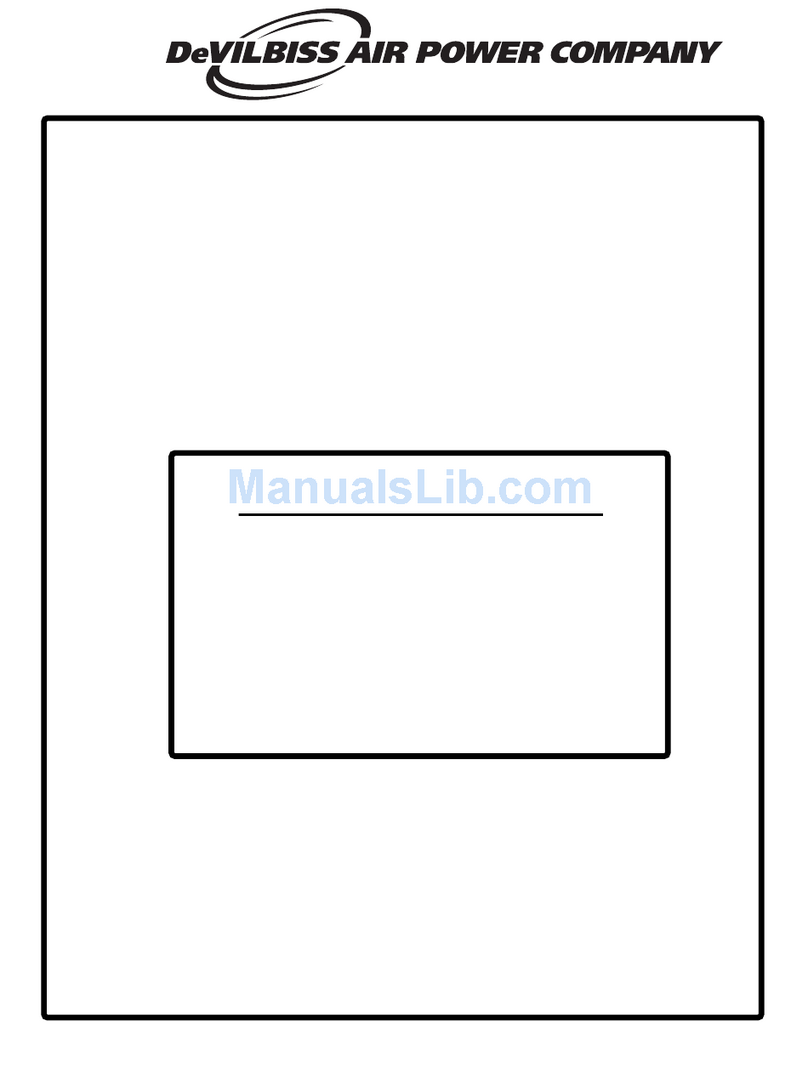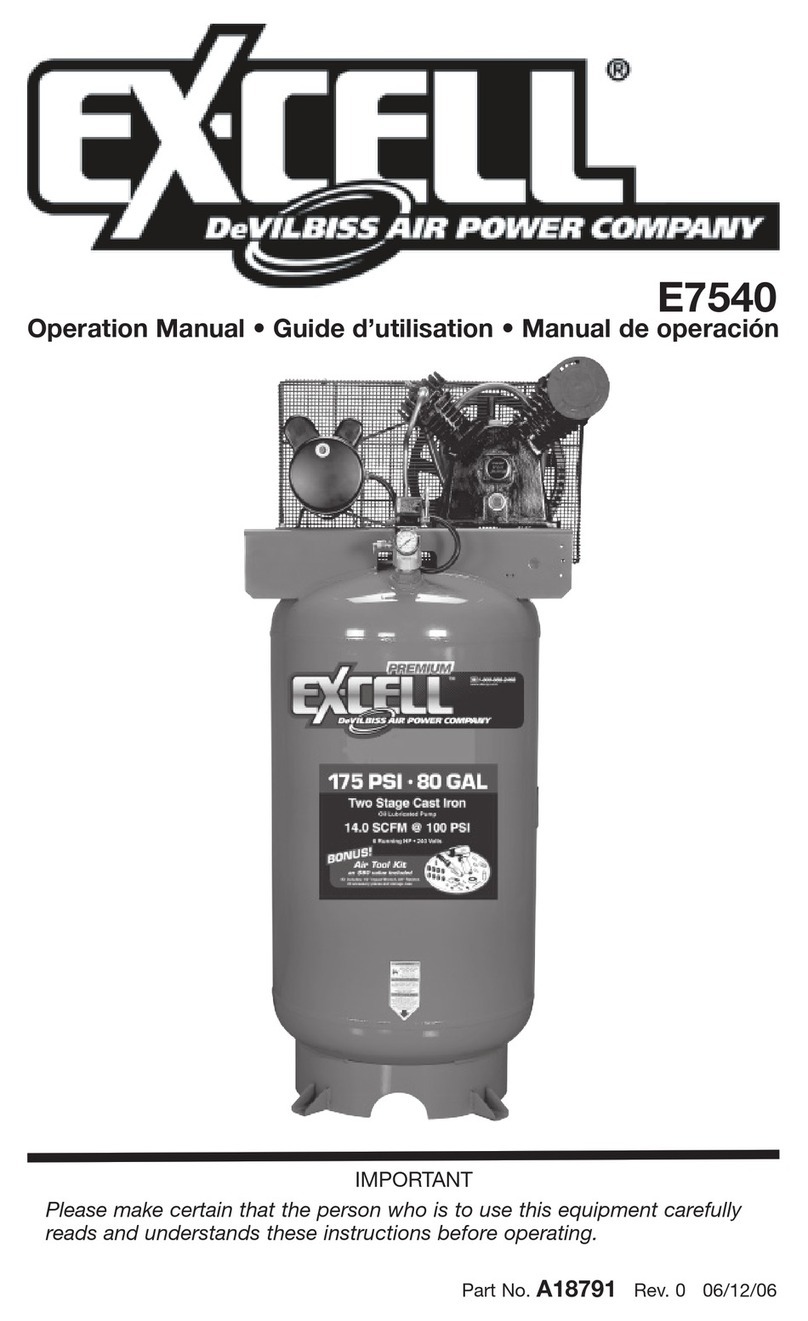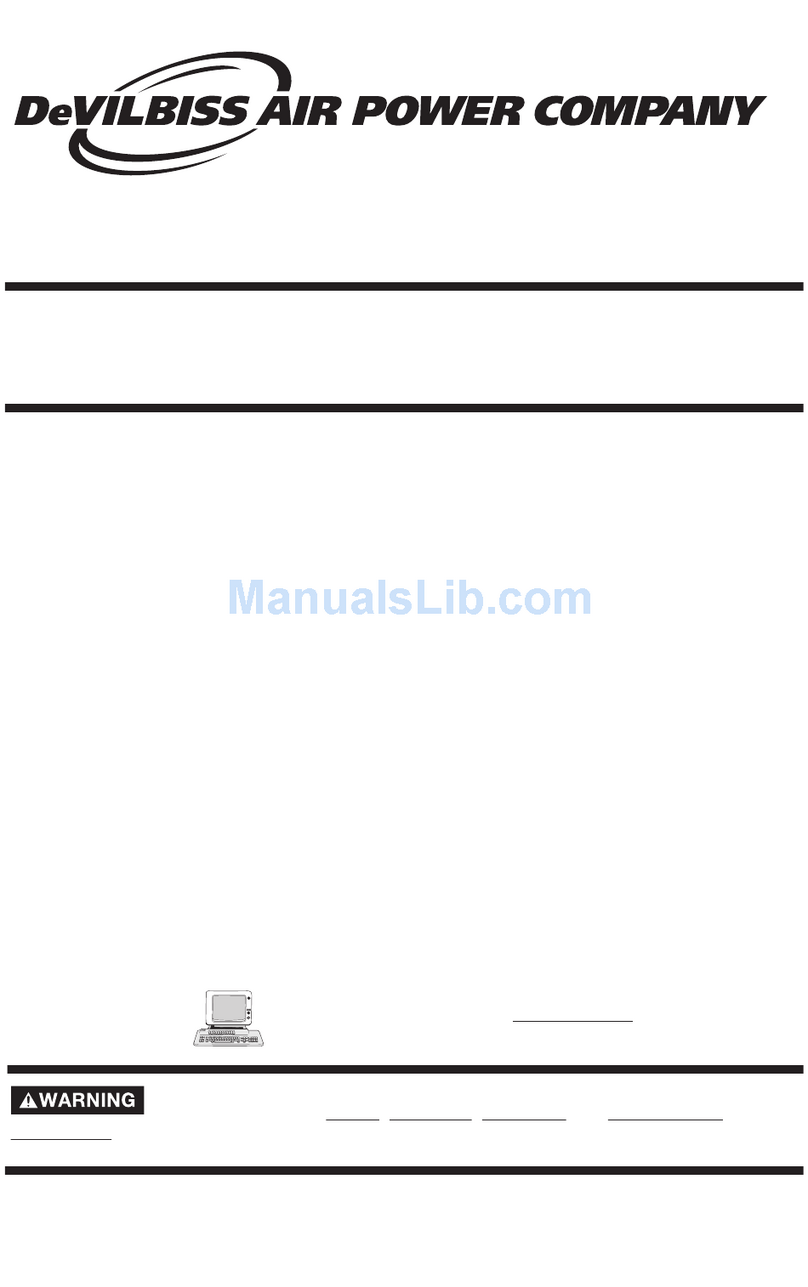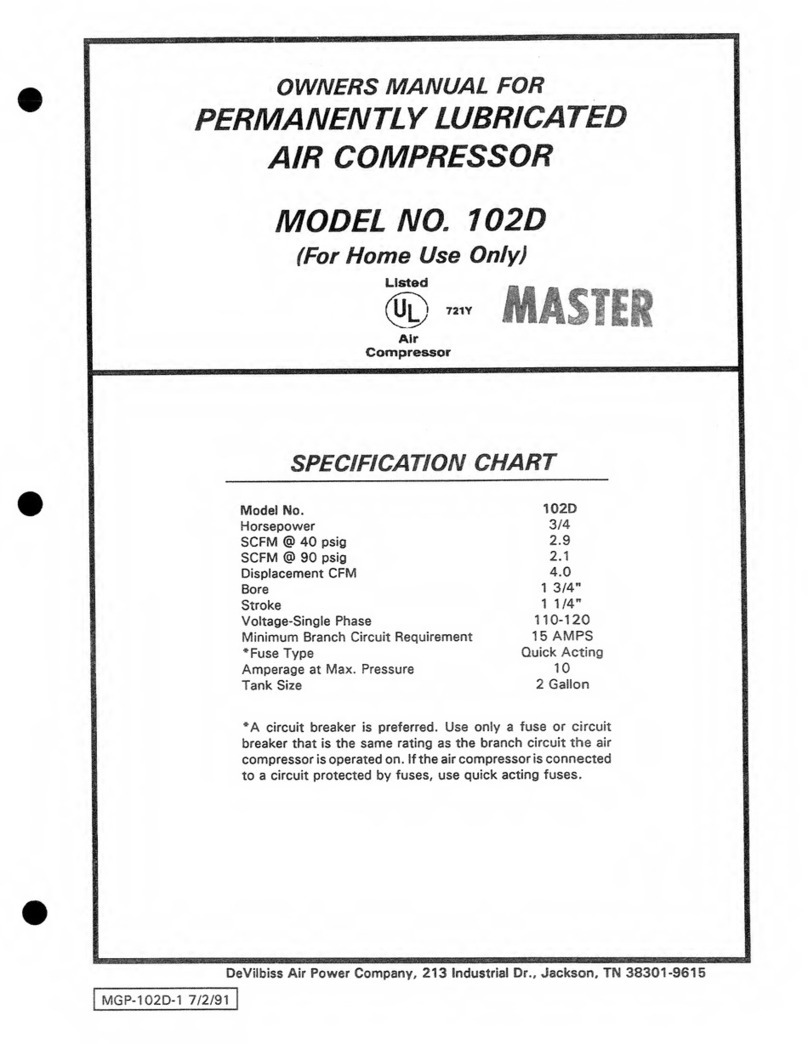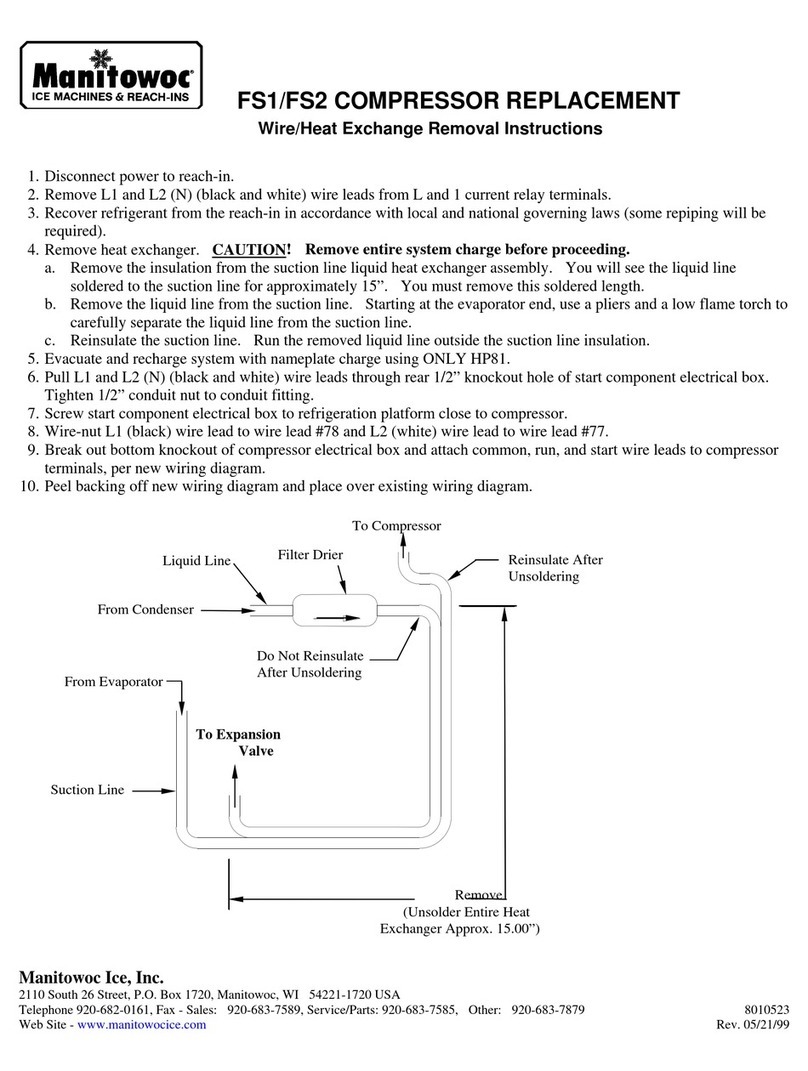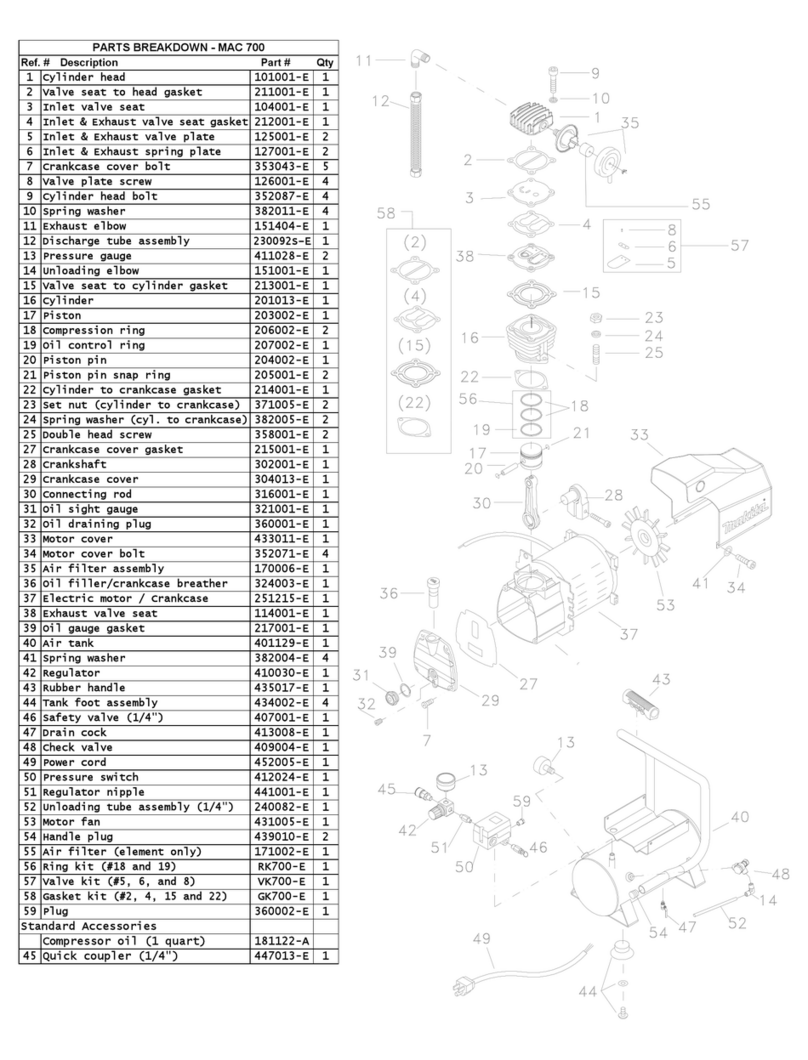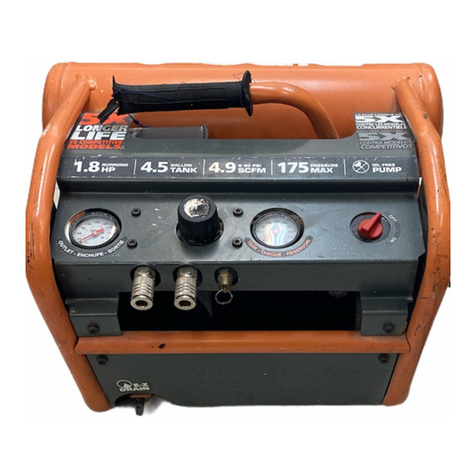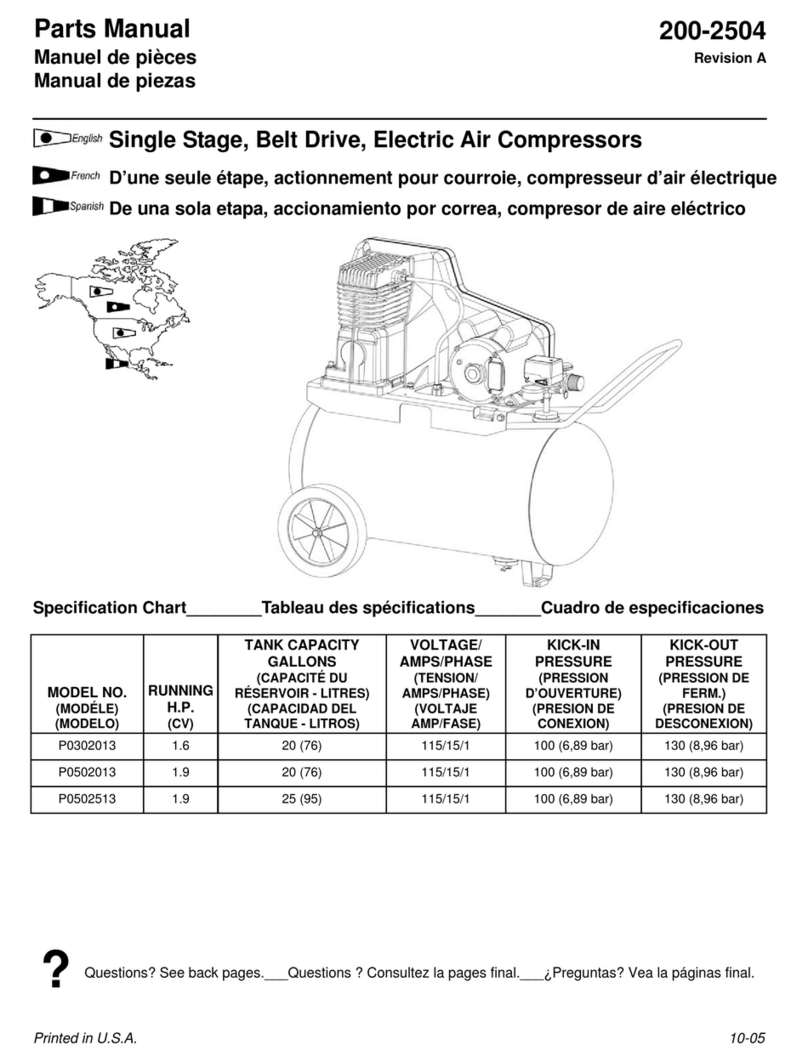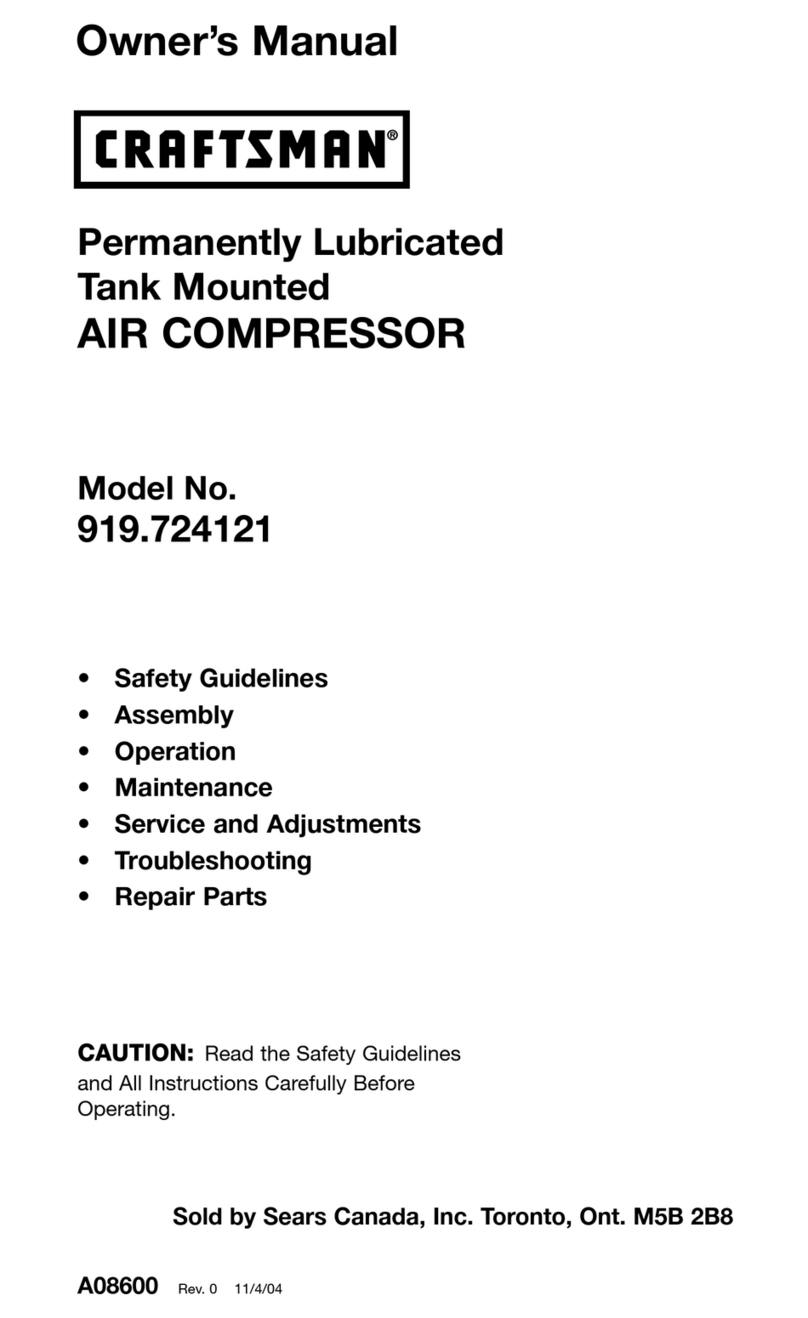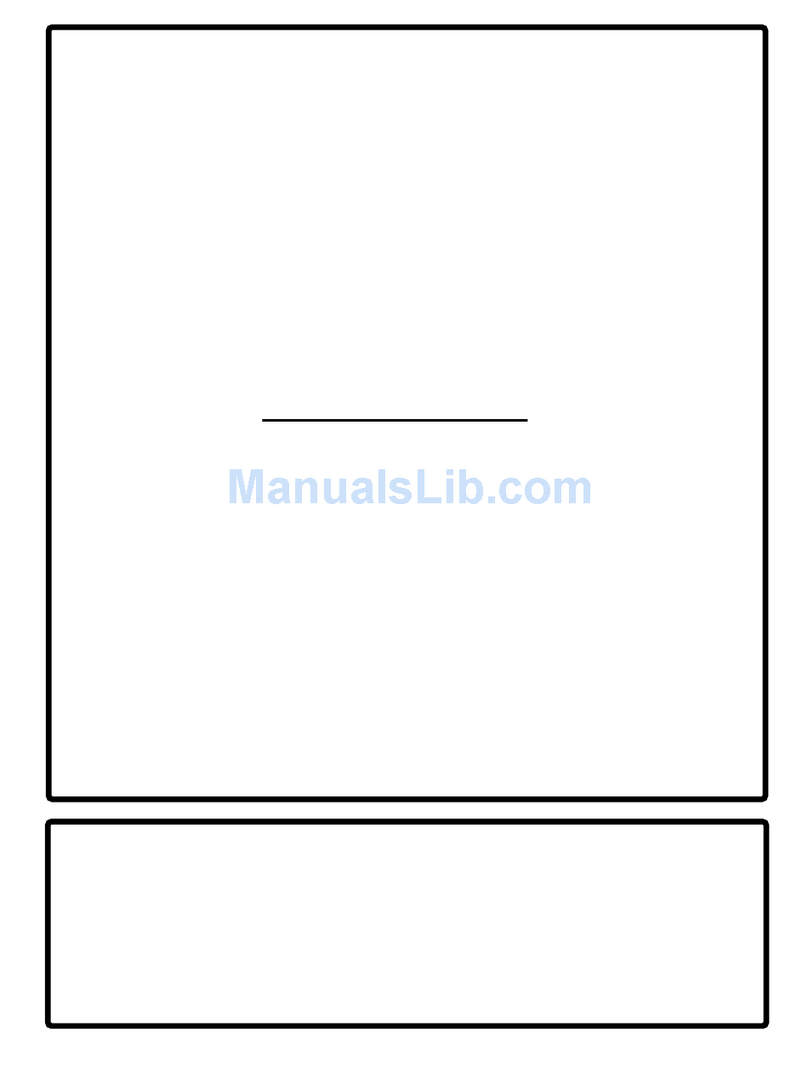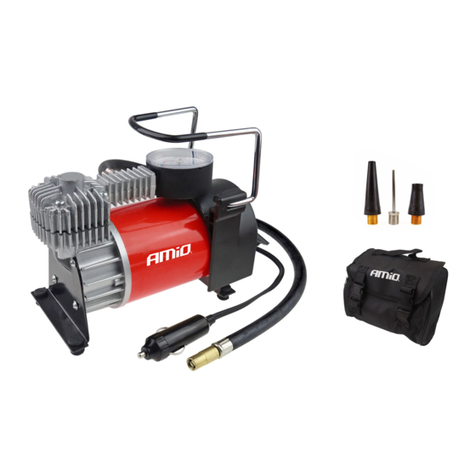DeVilbiss Air Power Company IRC5E60VAD-1 Configuration guide

MG5-OLSTAT-3A 6/18/99
General Manual
OilLubricatedSingleStageStationary
AirCompressors
SAFETY GUIDELINES - DEFINITIONS
Information for preventing damage to
equipment.
This manual contains information
that is important for you to know
and understand. This information
relates to protecting YOUR
SAFETYand PREVENTING
EQUIPMENT PROBLEMS. To
help you recognize this informa-
tion, we use the symbols to the
right. Please read the manual and
pay attention to these sections.
URGENT SAFETY INFORMATION - A HAZARD
THAT WILL CAUSE SERIOUS INJURY OR LOSS
OF LIFE.
Information that you should pay
special attention to.
IMPORTANT SAFETY INFORMATION - A
HAZARD THAT MIGHT CAUSE SERIOUS INJURY
OR LOSS OF LIFE.
Call ourToll Free Number 1-800-888-2468, Ext 2 , to obtain the location of the nearest Authorized Service
Center for ordering repair parts and for warranty repairs.
When ordering repair parts from your local Authorized Service Center, always give the following information:
•Model number of your product
•Part number and description of the item you wish to purchase
Retain Original Sales Receipt as Proof of Purchase for Warranty Repair Work.
TABLE OF CONTENTS
SAFETY GUIDELINES ........................................... 1
WARRANTY STATEMENT ..................................... 2
WARNING CHART ................................................. 3-4
SPECIFICATIONS................................................. 5
GLOSSARY ............................................................ 5
DUTY CYCLE ......................................................... 5
GENERAL INFORMATION .................................... 5
ON-RECEIPT INSPECTION .................................. 5
DESCRIPTION OF OPERATION ........................... 6
INSTALLATION AND
BREAK-IN PROCEDURES ................................... 6-9
Location of Air Compressor ................................. 6
Anchoring Methods ............................................. 6
Verticle Units ........................................................ 6
Voltage and Circuit Protection ............................. 7
Lubrication and Oil ............................................... 7
Additional Regulators and Controls .................... 7
Break-inProcedures ............................................ 7
Wiring Instruction ................................................ 7
Piping ................................................................... 8
OPERATING PROCEDURES ................................ 9-10
Daily Start-Up Checklist ............................... 9
Normal Operation ......................................... 9-10
MAINTENANCE ..................................................... 10
Routine Maintenance Schedule .................... 10
SERVICE INSTRUCTIONS ................................ 11-12
Air Filter - Inspection and
Replacement ........................................................ 11
Oil - Checking and Changing .............................. 11
Check Valve - Inspection and
Replacement ........................................................ 11
Safety Valve - Inspection and
Replacement ........................................................ 11
BeltReplacement................................................. 11
Belt Guard - Removal and Installation ................. 11
Adjusting Belt Tension ......................................... 12
Pressure Switch - Replacement ........................... 12
Motor Overload Protector - Reset ........................ 12
Pulley and Flywheel - Alignment .......................... 12
Servicing Intake and Exhaust Valves .................... 12
STORAGE ............................................................... 12
TROUBLESHOOTING GUIDE ............................... 13-15
Available from Allparts Equipment and Accessories - 1-877-475-5660 - www.allpartsinc.com

2
LIMITED WARRANTY
ONE YEAR FROM DATE OF PURCHASE
All merchandise manufactured by DeVilbiss Air Power Company/ExCell Manufacturing is warranted to be free of
defects in workmanship and material which occur during the first year from the date of purchase by the original
purchaser (initial user). Products covered under this warranty include: air compressors, *air tools, accessories, service
parts, pressure washers, and generators used in consumer applications (i.e., personal residential household usage
only).
Air compressors, *air tools, accessories, service parts, pressure washers, and generators used in commercial
applications (income producing) are covered by a 90 day warranty.
DeVilbiss Air Power/ExCell Manufacturing will repair or replace, at DeVilbiss/ExCell’s option, products or components
which have failed within the warranty period. Repair or replacement, and service calls on 60 and 80 gallon air
compressors, will be handled by Authorized Warranty Service Centers and will be scheduled and serviced according
to the normal work flow and business hours at the service center location, and depending on the availability of
replacement parts.
All decisions of DeVilbiss Air Power Company/ExCell Manufacturing with regard to this policy shall be final.
This warranty gives you specific legal rights, and you may also have other rights which vary from state to state.
Form: SP-100-F - 10/28/97
THIS WARRANTY DOES NOT COVER:
RESPONSIBILITY OF ORIGINAL PURCHASER (Initial User):
❏Retain original cash register sales receipt as proof of purchase for warranty work.
❏Use reasonable care in the operation and maintenance of the product as described in the Owners Manual(s).
❏Deliver or ship the product to the nearest DeVilbiss Air Power/ExCell Manufacturing Authorized Warranty
Service Center. Freight costs, if any, must be paid by the purchaser.
❏Air compressors with 60 and 80 gallon tanks only will be inspected at the site of installation. Contact the
nearest Authorized Warranty Service Center, that provides on-site service calls, for service call arrangement.
❏If the purchaser does not receive satisfactory results from the Authorized Warranty Service Center, the
purchaser should contact DeVilbiss Air Power Company/ExCell Manufacturing.
❏Merchandise sold as reconditioned, floor models and/or display models. Any damaged or incomplete equipment
sold "as is".
❏Merchandise used as "rental" equipment.
❏Merchandise that has become inoperative because of ordinary wear, misuse, freeze damage, use of improper
chemicals, negligence, accident, improper and/or unauthorized repair or alterations including failure to operate
the product in accordance with the instructions provided in the Owners Manual (s) supplied with the product.
*Air Tools: O-Rings and driver blades are considered ordinary wear parts, therefore, they are warranted for a
period of 45 days from the date of purchase.
❏An air compressor that pumps air more than 50% during a one hour period is considered misuse because
the air compressor is undersized for the required air demand. Maximum compressor pumping time per hour is
30 minutes.
❏Merchandise sold by DeVilbiss Air Power/ExCell Manufacturing which has been manufactured by and identified
as the product of another company. The product manufacturer's warranty will apply.
❏Repair and transportation costs of merchandise determined not to be defective.
❏Cost associated with assembly, required oil, adjustments or other installation and start-up cost.
❏ANY INCIDENTAL, INDIRECT OR CONSEQUENTIAL LOSS, DAMAGE, OR EXPENSE THAT MAY RESULT
FROM ANY DEFECT, FAILURE OR MALFUNCTION OF THE PRODUCT. Some states do not allow the
exclusion or limitation of incidental or consequential damages, so the above limitation or exclusion may not apply
to you.
❏IMPLIED WARRANTIES, INCLUDING THOSE OF MERCHANTABILITY AND FITNESS FOR A PARTICULAR
PURPOSE, ARE LIMITED TO ONE YEAR FROM THE DATE OF ORIGINAL PURCHASE. Some states do not
allow limitations on how long an implied warranty lasts, so the above limitations may not apply to you.
213 Industrial Drive • Jackson, TN 38301-9615
Telephone: 1-800-888-2468 , Ext. 2
FAX: 1-800-888-9036
Available from Allparts Equipment and Accessories - 1-877-475-5660 - www.allpartsinc.com

3
RISK OF BURSTING
RISK OF
EXPLOSION OR FIRE
AIR TANK
THE FOLLOWING CONDITIONS COULD
LEAD TO A WEAKENING OF THE TANK, AND
RESULT IN A VIOLENT TANK EXPLOSION:
1. FAILURE TO PROPERLY DRAIN
CONDENSED WATER FROM THE TANK,
CAUSING RUST AND THINNING OF THE
STEEL TANK.
2. MODIFICATIONS OR ATTEMPTED
REPAIRS TO THE TANK.
3. UNAUTHORIZED MODIFICATIONS TO
THE PRESSURE SWITCH, SAFETY
VALVE, OR ANY OTHER COMPONENTS
WHICH CONTROL TANK PRESSURE.
ATTACHMENTS & ACCESSORIES
EXCEEDING THE PRESSURE RATING OF AIR
TOOLS, SPRAY GUNS, AIR OPERATED
ACCESSORIES, TIRES AND OTHER
INFLATABLES CAN CAUSE THEM TO EX-
PLODE OR FLY APART, AND COULD RESULT
IN SERIOUS INJURY.
EXCESSIVE VIBRATION CAN WEAKEN THE
AIR TANK OF A STATIONARY COMPRESSOR
AND CAUSE AN EXPLOSION.
IT IS NORMAL FOR ELECTRICAL
CONTACTS WITHIN THE MOTOR AND PRES-
SURE SWITCH TO SPARK.
IF ELECTRICAL SPARKS FROM COMPRES-
SOR COME INTO CONTACT WITH
FLAMMABLE VAPORS, THEY MAY IGNITE,
CAUSING FIRE OR EXPLOSION.
RESTRICTING ANY OF THE COMPRESSOR
VENTILATION OPENINGS WILL CAUSE SERI-
OUS OVERHEATING AND COULD CAUSE
FIRE.
DRAIN TANK DAILY OR AFTER EACH USE.
IF TANK DEVELOPS A LEAK, REPLACE IT
IMMEDIATELY WITH A NEW TANK OR NEW
COMPRESSOR OUTFIT.
NEVER DRILL INTO, WELD, OR MAKE ANY
MODIFICATIONS TO THE TANK OR ITS
ATTACHMENTS.
THE TANK IS DESIGNED TO WITHSTAND
SPECIFIC OPERATING PRESSURES. NEVER
MAKE ADJUSTMENTS OR PARTS SUBSTI-
TUTIONS TO ALTER THE FACTORY SET
OPERATING PRESSURES.
FOR ESSENTIAL CONTROL OF AIR PRES-
SURE, YOU MUST INSTALL A PRESSURE
REGULATOR AND PRESSURE GAUGE TO
THE AIR OUTLET OF YOUR COMPRESSOR.
FOLLOW THE EQUIPMENT MANUFACTUR-
ERS RECOMMENDATION AND NEVER
EXCEED THE MAXIMUM ALLOWABLE PRES-
SURE RATING OF ATTACHMENTS. NEVER
USE COMPRESSOR TO INFLATE SMALL
LOW-PRESSURE OBJECTS SUCH AS
CHILDREN’S TOYS, FOOTBALLS,
BASKETBALLS. ETC.
THE COMPRESSOR MUST BE PROPERLY
MOUNTED, SEE INSTALLATION PROCE-
DURES.
ALWAYS OPERATE THE COMPRESSOR IN A
WELL VENTILATED AREA FREE OF COM-
BUSTIBLE MATERIALS, GASOLINE OR
SOLVENT VAPORS.
IF SPRAYING FLAMMABLE MATERIALS,
LOCATE COMPRESSOR AT LEAST 20 FEET
AWAY FROM SPRAY AREA. AN ADDITIONAL
LENGTH OF HOSE MAY BE REQUIRED.
STORE FLAMMABLE MATERIALS IN A
SECURE LOCATION AWAY FROM COM-
PRESSOR.
NEVER PLACE OBJECTS AGAINST OR ON
TOP OF COMPRESSOR. OPERATE COM-
PRESSOR IN AN OPEN AREA AT LEAST 12
INCHES AWAY FROM ANY WALL OR
OBSTRUCTION THAT WOULD RESTRICT
THE FLOW OF FRESH AIR TO THE VENTILA-
TION OPENINGS.
HAZARD WHAT CAN HAPPEN HOW TO PREVENT IT
• SAVE THESE INSTRUCTIONS •
IMPORTANT SAFETY INSTRUCTIONS
IMPROPER OPERATION OR MAINTENANCE OF THIS PRODUCT COULD RESULT IN SERIOUS INJURY
AND PROPERTY DAMAGE. READ AND UNDERSTAND ALL WARNINGS AND OPERATING INSTRUCTIONS
BEFORE USING THIS EQUIPMENT.
CONTINUE NEXT PAGE
*
Available from Allparts Equipment and Accessories - 1-877-475-5660 - www.allpartsinc.com

4
HAZARD
RISK OF
ELECTRICAL SHOCK
RISK FROM
FLYING OBJECTS
RISK TO BREATHING
RISK FROM
MOVING PARTS
RISK OF BURNS
WHAT CAN HAPPEN
YOUR AIR COMPRESSOR IS POWERED BY
ELECTRICITY. LIKE ANY OTHER ELECTRI-
CALLY POWERED DEVICE, IF IT IS NOT USED
PROPERLY IT MAY CAUSE ELECTRIC SHOCK.
REPAIRS ATTEMPTED BY UNQUALIFIED PER-
SONNEL CAN RESULT IN SERIOUS INJURY OR
DEATH BY ELECTROCUTION.
ELECTRICAL GROUNDING: FAILURE TO
PROVIDE ADEQUATE GROUNDING TO THIS
PRODUCT COULD RESULT IN SERIOUS
INJURY OR DEATH FROM ELECTROCUTION.
SEE GROUNDING INSTRUCTIONS.
THE COMPRESSED AIR STREAM CAN CAUSE
SOFT TISSUE DAMAGE TO EXPOSED SKIN AND
CAN PROPEL DIRT, CHIPS, LOOSE PARTICLES
AND SMALL OBJECTS AT HIGH SPEED,
RESULTING IN PROPERTY DAMAGE OR PER-
SONAL INJURY.
THE COMPRESSED AIR FROM YOUR COM-
PRESSOR IS NOT SAFE FOR BREATHING! THE
AIR STREAM MAY CONTAIN CARBON MONOX-
IDE, TOXIC VAPORS OR SOLID PARTICLES.
SPRAYED MATERIALS SUCH AS PAINT, PAINT
SOLVENTS, PAINT REMOVER, INSECTICIDES,
WEED KILLERS, ETC.. CONTAIN HARMFUL
VAPORS AND POISONS.
THE COMPRESSOR CYCLES AUTOMATI-
CALLY WHEN THE PRESSURE SWITCH IS IN
THE ON/AUTO POSITION.
MOVING PARTS CAN CAUSE SERIOUS INJURY
OR DAMAGE IF THEY COME INTO CONTACT
WITH YOU OR YOUR CLOTHING.
ATTEMPTING TO OPERATE OR REPAIR
COMPRESSOR WITH PROTECTIVE SHROUDS
REMOVED CAN EXPOSE YOU TO MOVING
PARTS AND ELECTRICAL SHOCK.
TOUCHING EXPOSED METAL SUCH AS THE
COMPRESSOR HEAD OR OUTLET TUBE CAN
RESULT IN SERIOUS BURNS.
HOW TO PREVENT IT
NEVER OPERATE THE COMPRESSOR OUT-
DOORS WHEN IT IS RAINING OR IN WET
CONDITIONS.
NEVER OPERATE COMPRESSOR WITH COVER
COMPONENTS REMOVED OR DAMAGE.
ANY ELECTRICAL WIRING OR REPAIRS RE-
QUIRED ON THIS PRODUCT SHOULD BE
PERFORMED BY AUTHORIZED SERVICE CEN-
TER PERSONNEL IN ACCORDANCE WITH
NATIONAL AND LOCAL ELECTRICAL CODES.
MAKE CERTAIN THAT THE ELECTRICAL
CIRCUIT TO WHICH THE COMPRESSOR IS
CONNECTED PROVIDES PROPER ELECTRICAL
GROUNDING, CORRECT VOLTAGE AND AD-
EQUATE FUSE PROTECTION.
ALWAYS WEAR ANSI Z87.1 APPROVED SAFETY
GLASSES WITH SIDE SHIELDS WHEN USING
THE COMPRESSOR.
NEVER POINT ANY NOZZLE OR SPRAYER
TOWARD ANY PART OF THE BODY OR AT
OTHER PEOPLE OR ANIMALS.
ALWAYS TURN OFF THE COMPRESSOR,
BLEED PRESSURE FROM THE AIR HOSE AND
TANK, AND DISCONNECT FROM POWER
SOURCE BEFORE PERFORMING MAINTE-
NANCE OR ATTACHING TOOLS AND ACCES-
SORIES.
NEVER INHALE AIR FROM THE COMPRESSOR
EITHER DIRECTLY OR FROM A BREATHING
DEVICE CONNECTED TO THE COMPRESSOR.
WORK IN AN AREA WITH GOOD CROSS-
VENTILATION. READ AND FOLLOW THE
SAFETY INSTRUCTIONS PROVIDED ON THE
LABEL OR SAFETY DATA SHEETS FOR THE
MATERIAL YOU ARE SPRAYING. USE A
NIOSH/MSHA APPROVED RESPIRATOR DE-
SIGNED FOR USE WITH YOUR SPECIFIC
APPLICATION.
ALWAYS TURN OFF THE COMPRESSOR,
BLEED PRESSURE FROM THE AIR HOSE AND
TANK, AND DISCONNECT FROM POWER
SOURCE BEFORE PERFORMING MAINTE-
NANCE OR ATTACHING TOOLS AND ACCES-
SORIES.
DO NOT REMOVE THE PROTECTIVE COVERS
FROM THIS PRODUCT. NEVER OPERATE THE
COMPRESSOR WITH GUARDS OR COVERS
WHICH ARE DAMAGED OR REMOVED.
ANY REPAIRS REQUIRED ON THIS PRODUCT
SHOULD BE PERFORMED BY AUTHORIZED
SERVICE CENTER PERSONNEL.
NEVER TOUCH ANY EXPOSED METAL PARTS
ON COMPRESSOR DURING OR IMMEDIATELY
AFTER OPERATION. COMPRESSOR WILL
REMAIN HOT FOR SEVERAL MINUTES AFTER
OPERATION.
DO NOT REACH AROUND PROTECTIVE
SHROUDS OR ATTEMPT MAINTENANCE UNTIL
UNIT HAS BEEN ALLOWED TO COOL.
SCWORPOL — 7/23/97
Available from Allparts Equipment and Accessories - 1-877-475-5660 - www.allpartsinc.com

5
Refer to Outfit Part Listing for the specifications of your compres-
sor. Use only a fuse or circuit breaker that is the same rating as the
branch circuit the air compressor is operated on. If the compressor
is connected to a circuit protected by fuses, use dual element time
delay fuses, as noted in the Outfit Parts Listing.
Improper electrical installation of this product
may void its warranty and your fire insurance.
Have circuit wiring performed by qualified per-
sonnel such as a licensed electrician who is
familiar with the current national electric code
and any prevailing local electrical codes.
GLOSSARY
CFM: Cubic feet per minute.
SCFM: Standard cubic feet per minute; a unit of measure of air
delivery.
PSIG: Pounds per square inch gauge; a unit of measure of
pressure.
ASME: American Society of Mechanical Engineers; made, tested,
inspected and registered to meet the standards of ASME.
California Code: Unit may comply with California Code 462 (L)
(2) / (M) (2). Specification/Model label is on the side of the tank on
units that comply with California Code.
To Lock Out Power: Place a lock on the line power switch so no
one else can turn on the power.
Cut-In Pressure: While the motor is off, air tank pressure drops
as you continue to use your accessory or air tool. When the tank
pressure drops to a certain low level the motor will restart auto-
matically. The low pressure at which the motor automatically re-
starts is called “cut-in pressure.”
Cut-Out Pressure: When you turn on your air compressor and it
begins to run, air pressure in the air tank begins to build. It builds
to a certain high pressure before the motor automatically shuts off
- protecting your air tank from pressure higher than its capacity.
The high pressure at which the motor shuts off is called “cut-out
pressure.”
All DeVilbiss Air Power manufactured air compressors should be
operated on not more than a 50% duty cycle. This means an air
compressor that pumps air more than 50% of one hour, is
DUTY CYCLE
considered misuse, because the air compressor is undersized for
the required air demand. Maximum compressor pumping time per
hour is 30 minutes.
You have purchased an air compressor unit consisting of an
aluminum 2 cylinder, single-stage air compressor pump (with cast
iron sleeves), an air tank, and associated controls and instru-
ments. You will also find a Parts Manual.
Your air compressor can be used for operating paint spray guns,
air tools, caulking guns, grease guns, air brushes, sandblasters,
inflating tires and plastic toys, or spraying weed killers, insecti-
cides, etc. An air pressure regulator is required for most of these
applications.
An air line filter is usually required for removal of moisture and oil
vapor in compressed air when a paint spray gun is used.
ON-RECEIPT INSPECTION
Each air compressor outfit is carefully tested and checked before
shipment. With improper handling, damage may result in transit
and cause problems in compressor operation.
Immediately upon arrival, check equipment for both concealed
and visible damages to avoid expenses being incurred to correct
such problems. This should be done regardless of any visible signs
of
damage to the shipping container. If this product was shipped
directly to you, report any damages to carrier and arrange for
inspection of goods immediately.
For the location or a listing of the nearest DeVilbiss Air Power
Authorized Warranty Service Center, call our toll free number at
1-800-888-2468, Ext. 2.
GENERAL INFORMATION
An in-line lubricator is usually required for air tools to prolong tool
life.
Separate air transformers which combine the functions of air
regulation and/or moisture and dirt removal should be used where
applicable.
A regularly scheduled program of preventive maintenance will
help provide the long life that has been designed into your
compressor outfit. Before operating or performing any mainte-
nance on your compressor, refer to this manual and your Outfit
Parts Manual. To keep your compressor in good working order,
refer to these publications often and perform preventive mainte-
nance steps as recommended.
SPECIFICATIONS
Available from Allparts Equipment and Accessories - 1-877-475-5660 - www.allpartsinc.com

6
Operate the air compressor in a clean, dry and well ventilated area.
The air intake filter must be kept clear of obstructions which could
reduceair delivery of the aircompressor. The air compressor should
be located at least 12" away from walls or other obstructions that
could interfere with the flow of air through the fan bladed flywheel.
The air compressor crankcase and head are designed with fins to
provide proper cooling.
The flywheel side of the outfit should be placed toward the wall and
protected with a totally enclosed belt guard. In no case should the
flywheel be closer than 12 to 18 inches from the wall or other
obstruction that will interfere with the flow of air through the fan
bladed flywheel. The area should allow space on all sides for air
circulationandfor ease of normal maintenance. Keep the outfitaway
from areas which have dirt, vapor, and volatile fumes in the atmo-
sphere which may clog and gum the intake filter and valves, causing
inefficient operation.
If humidity is high, an air filter can be installed in line to remove
excessive moisture. Closely follow instructions packaged with the
filter for proper installation. It must be installed as close as possible
to the accessory.
The air compressor should be as near to air outlets as possible in
orderto avoid long pipe lines. Do notplacethe air compressor where
heat is excessive.
Do not use an extension cord. To avoid voltage drop and power loss
to the motor, use extra air hose instead of an extension cord.
Anchoring of Vertical Unit
INSTALLATION AND BREAK-IN PROCEDURES
THE MANIFOLD ASSEMBLY DOES NOT PROVIDE
ADEQUATESTABILITYOR SUPPORT FOR LIFTING
THE UNIT. IF THE OUTFIT MUST BE MOVED, USE
THE TANK FOR LIFTING.
VIBRATIONCANWEAKEN THEAIRTANKAND CAUSE
ANEXPLOSION.THE COMPRESSORMUSTBEPROP-
ERLY MOUNTED AS ILLUSTRATED BELOW.
Air Compressor Anchoring Methods
Location of the Air Compressor
DESCRIPTION OF OPERATION
DrainValve: The drain valve islocated at the base ofthe air tank and
is used to drain condensation at the end of each use.
Motor Thermal Overload Protector: The electric motor has an
automaticthermal overload protector. If themotor overheats for any
reason, the thermal overload protector will shut off the motor. The
motor must be allowed to cool before restarting.
ON/AUTO - OFF Switch: Turn this switch ON to provide automatic
power to the pressure switch and OFF to remove power at the end
of each use.
Air Intake Filter: This filter is designed to clean air coming into the
pump. This filter must always be clean and ventilation openings free
from obstructions. See "Maintenance".
AirCompressorPump: To compress air, the pistons movesupand
down in the cylinder. On the downstroke, air is drawn in through the
airintakevalves. Theexhaustvalveremains closed. On the upstroke
of the piston, air is compressed. The intake valves close and
compressed air is forced out through the exhaust valve, through the
outlet tube, through the check valve and into the air tank. Working
air is not available until the compressor has raised the air tank
pressure above that required at the air outlet.
CheckValve: Whentheaircompressorisoperating,thecheck valve
is “open”, allowing compressed air to enter the air tank. When the
aircompressorreaches“cut-out”pressure,the check valve “closes”,
allowing air pressure to remain inside the air tank.
PressureReleaseValve: The pressure release valve located onthe
side of the pressure switch, is designed to automatically release
compressedair from the compressor headand the outlet tube when
the air compressor reaches “cut-out” pressure or is shut off. If the
airis not released, the motor will tryto start, but will be unableto. The
pressure release valve allows the motor to restart freely. When the
motor stops running, air will be heard escaping from the valve for a
few seconds. No air should be heard leaking when the motor is
running, or continuous leaking after unit reaches cut-out pressure.
Pressure Switch: The pressure switch automatically starts the
motor when the air tank pressure drops below the factory set “cut-
in” pressure. It stops the motor when the air tank pressure reaches
the factory set “cut-out” pressure.
Shut-off Valve: Turn the knob counterclockwise to open the valve
and clockwise to close.
Safety Valve: If the pressure switch does not shut off the air
compressor at its cut-out pressure setting, the safety valve will
protect against high pressure by “popping out” at its factory set
pressure (slightly higher than the pressure switch cut-out setting).
Tank Pressure Gauge: The tank pressure gauge indicates the
reserveairpressurein the tank. On outfits with no pressure regulator,
this is also the pressure available at the air outlet.
Vertical Units
Thiscompressor should be permanently mountedin place on a level
floor.Vertical air compressors must be bolted to the floor. Bolting
holes are provided in the base feet. Mount the air compressor on a
solid,levelfoundation. Support compressor weight evenly on all four
feet. Solid shims may be used if necessary.
Available from Allparts Equipment and Accessories - 1-877-475-5660 - www.allpartsinc.com

7
Compressorsareshipped withoutoil. Asmallamount
of oil may be present in the pump upon receipt of the
air compressor. This is due to plant testing and does
notmeanthatthepumpcontainsthecorrectamount
of oil. Do not attempt to operate this air compressor
without first adding oil to the crankcase. Serious
damage can result from even limited operation un-
less filled with oil and broken in correctly. Make sure
to closely follow initial start-up procedures.
Place unit on a level surface. Remove oil fill plug and slowly add a
compressor oil such as Castrol Heavy Duty 30 weight until it is even
with the top of the oil fill hole. (It must not be allowed to be lower than
3/8" -- 6 threads down -- from the top at any time.) When filling the
crankcase, the oil flows very slowly into the pump. If the oil is added
too quickly, it will overflow and appear to be full. Crankcase oil
capacity is 16 fluid ounces. Replace oil fill plug and tighten.
NOTE
Drain and refill the compressor pump crankcase
after the first 100 hours of operation.
Additional Regulators and Controls
Since the air tank pressure is usually greater than that which
isneeded,aseparateregulatorisusuallyemployedtocontrol
the air pressure ahead of any individual air driven device.
Separate air transformers which combine the function of air
regulation, moisture and dirt removal should be used where
applicable.
This procedure is required:
1. Before the air compressor is put into service.
2. When the check valve is replaced.
3. When a complete compressor pump is replaced.
a. Set the pressure switch lever to the "OFF" position.
b. Connect compressor to power source. (See Wiring
Instructions).
c. Turn the regulator clockwise (or open the shut-off valve),
opening it fully, to prevent air pressure build-up in the tank.
d. Move the pressure switch lever to "ON/AUTO". The
compressor will start.
INSTALLATION AND BREAK-IN PROCEDURES (cont'd)
IMPROPER ELECTRICAL GROUNDING CAN RESULT
IN A RISK OF ELECTRICAL SHOCK. WIRING FOR THE
PRESSURE SWITCH AND ELECTRICAL MOTOR
SHOULD BE DONE BY A LICENSED ELECTRICIAN IN
ACCORDANCE WITH NATIONAL AND LOCAL CODES
AND ORDINANCES.
Serious damage may result if the following break-in
instructions are not closely followed.
Break-in Procedures
Wiring Instructions
Perform electrical wiring according to the following instructions:
Install the compressor outfit as close to the main power supply as
possible. This practice will avoid using long lengths of electrical
wiringforthepowersupplywhichcancausepowerlossanddamage
to the motor. When connecting wires make sure that:
1. Theamperagerating of the electrical box is adequate.Referto the
Specification Chart in the Outfit Parts Manual for your air com
pressor outfit.
2. The supply line has the same electrical characteristics (voltage,
cycle, and phase) as motor.
Wiring must be such that full motor nameplate voltage plus or minus
10%,isavailableatthe motor terminals during starting. Refer to local
codes for recommended wire sizes and maximum wire run; under-
sized wire causes high amp draw and overheating to the motor.
Electrical wiring must be located away from hot sur-
faces such as the compressor head, compressor
cylinder, or compressor outlet tube.
Improper electrical installation of this product may
voidits warranty and your fire insurance.Have circuit
wiring performed by qualified personnel such as a
licensed electrician who is familiar with the current
nationalelectriccodeandanyprevailinglocal electri-
cal codes.
Lubrication and Oil
Multi-Viscositymotoroils,like10W 30, should not be
usedinanaircompressor.Theyleavecarbondepos-
its on critical components, thus reducing perfor-
mance and compressor life. Use air compressor oil
only.
Voltage and Circuit Protection
Refer to your Outfit Parts Manual for the voltage and circuit
protection requirements of your compressor. Use only a fuse or
circuit breaker that is the same rating as the branch circuit the air
compressor is operated on. If the compressor is connected to a
circuit protected by fuses, use only dual element time delay fuses,
as noted in that Outfit Parts Manual.
e. Run the compressor for 30 minutes. Make sure the
regulator, or shut-off valve, is open and there is no tank
pressure build-up during this time.
f. After 30 minutes, close the regulator by turning it
counterclockwise or close the shut-off valve by turning the
knob clockwise. The air receiver will fill to cut-out pressure
andthe motor will stop. The compressoris now ready for use.
Available from Allparts Equipment and Accessories - 1-877-475-5660 - www.allpartsinc.com

8
Piping
A typical compressed air distribution system below should be of
sufficient pipe size to keep the pressure drop between the supply
and point of use to a minimum. All pipes and fittings used must be
certifiedsafe for the pressures involved.Pipe thread lubricant must
be used on all threads, and all joints are to be made up tight, since
small leaks in the piping system are the largest single cause of high
operating costs.
All piping should be sloped to an accessible drain point and all
outlets should be taken from the top of the main distribution air line
so that moisture cannot enter the outlet.
The main distribution air line should not be smaller than the
compressor air discharge valve outlet. A smaller line will restrict the
flow of air. If piping is over 100 feet long, or if required air flow will
exceed 15 SCFM, use 3/4" piping.
It is recommended that a flexible coupling be installed between the
air discharge valve outlet and main air distribution line to allow for
vibration.
To remove dirt, oil and water, install a separator in the main
distribution line. Install separator 5 to 6 feet from compressor to
allowtheair to cool to room temperature before passing through the
separator. Additional separators or filters may be used depending
on the application.
Note
For underground installation, bury air lines
below the frost line and avoid pockets where
condensation can gather and freeze. Apply
pressure before underground lines are cov-
ered to make sure all pipe joints are free from
leaks.
Plastic or PVC pipe is not designed for use with
compressedair.Regardless of itsindicatedpres-
sure rating, plastic pipe can burst from air pres-
sure.Useonlymetalpipe for air distribution lines.
Note
Where a remote air intake is used, enlarge
the size of the air intake piping by one pipe
size for each 10 feet of length.
INSTALLATION AND BREAK-IN PROCEDURES (cont'd)
Wiring of Compressor Units
Available from Allparts Equipment and Accessories - 1-877-475-5660 - www.allpartsinc.com

9
INSTALLATION AND BREAK-IN PROCEDURES (cont'd)
Typical Compressed Air Distribution System
OPERATING PROCEDURES
Daily Start-Up Checklist
Perform the following checks before starting the compres-
sor outfit.
1. Make sure that nothing is blocking the belt guard air open-
ings or air filter opening.
2. Pull the ring on all safety valves to make sure the valves move
freely and smoothly.
3. Check the oil level; add oil if necessary.
4. Clean or blow off fins or any part of compressor that collects
dust and dirt. Compressor will run cooler and provide longer
service.
Start the compressor outfit and check the following:
1. With the outlet valve closed, start the compressor
outfit. Allow the outfit to pump up to cut-off
pressure.
2. Make sure that all controls are operating correctly.
Refer to "Description of Operation" section of this
manual.
3. Check all line fittings and piping for air leaks. Even
minor leaks can cause the compressor to over
work, resulting in premature breakdown or
unsatisfactory performance.
4. Check for any unusual vibration and noise.
5. Check for oil leaks. Correct any leaks found.
Compressed air from the outfit may contain
water condensation and oil mist. Do not spray
unfiltered air at an item that could be damaged
by moisture or oil mist. Some air operated tools
or devices may require filtered air. Read in-
structions for the air tool or device.
6. Open shut-off valve. Your outfit is ready for use.
When You Are Finished:
7. Set the pressure switch lever to "OFF".
8. Close the shut-off valve.
9. Remove the air tool or accessory.
10. Open the shut-off valve and allow the air to slowly bleed from
the tank. Close shut-off valve when tank pressure is approxi-
mately 20 PSI.
Normal Operation
1. Before attaching an air hose or accessory, make sure the
pressure switch lever is in the "OFF" position. Close the
shut-off valve by turning the knob clockwise, or close air
regulator outlet by turning it counterclockwise.
2. Attach hose and accessory.
Available from Allparts Equipment and Accessories - 1-877-475-5660 - www.allpartsinc.com

10
UNIT CYCLES AUTOMATICALLY WHEN POWER IS ON. DURING MAINTENANCE, YOU COULD BE EXPOSED TO VOLTAGE
SOURCES, COMPRESSED AIR OR MOVING PARTS. PERSONAL INJURIES CAN OCCUR. UNPLUG THE UNIT AND BLEED OFF ALL
AIR TANK PRESSURE BEFORE DOING ANY MAINTENANCE OR REPAIR. NEVER OPERATE THE UNIT WITH THE BELT GUARD
REMOVED.
2. Increase frequency of oil changes if humidity or operating
conditions are extreme.
Every 160 Hours of Operation:
1. Check drive belt tension; adjust if necessary. (Refer to SER-
VICE INSTRUCTIONS in this manual.)
2. Inspect air lines and fittings for leaks; correct as necessary.
3. Check the alignment of the motor pulley to the flywheel. If
necessary, align to within 1/32 inch on center line.
Each Year of Operation or if a Problem
is Suspected:
Check condition of air compressor pump intake and exhaust
valves. Replace if damaged or worn out.
MAINTENANCE
Normal Operation (cont'd)
TOO MUCH AIR PRESSURE CAUSES A HAZ-
ARDOUS RISK OF BURSTING. CHECK THE
MANUFACTURER'S MAXIMUM PRESSURE
RATING FOR AIR TOOLS AND ACCESSORIES.
THE REGULATOR OUTLET PRESSURE MUST
NEVER EXCEED THE MAXIMUM PRESSURE
RATING. ON MODELS HAVING ONLY A SHUT-
OFF VALVE, YOU MUST INSTALL A REGULA-
TORBEFORE USING ACCESSORIES RATED AT
LESS THAN 125 PSIG.
3. Turn the pressure switch lever to the "ON-AUTO" position and
allow tank pressure to build. The motor will stop when tank
pressure reaches cut-out pressure. Slowly release air pres-
sure from globe valve.
4. The compressor is now ready for use.
6. After the water has been drained, close the drain cock. The air
compressor can now be stored.
NOTE
If the drain cock valve is plugged, release all
air pressure. The valve can then be removed,
cleaned and reinstalled.
DRAIN TANK DAILY. WATER WILL CONDENSE
IN THE AIR TANK. IF NOT DRAINED, WATER
WILL CORRODE AND WEAKEN AIR TANK,
CAUSING A RISK OF AIR TANK RUPTURE.
OPERATING PROCEDURES (cont'd)
5. When You Are Finished: drain tank pressure at approxi-
mately 20 PSI, open the drain valve and allow moisture to drain.
Routine Maintenance Schedule
Daily:
1. Check oil level. Add if necessary.
2. Drain water from the air tank, any moisture separators or
transformers.
3. Check for any unusual noise and/or vibration.
4. Manually check all safety valves to make sure they are
operating properly.
5. Inspect for oil leaks and repair any leaks found.
6. Inspect air filter, replace if necessary.
Every 40 Hours of Operation:
1. Inspect condition of drive belt; replace if necessary
Every 100 Hours of Operation:
1. Drain and refill compressor crankcase with 16 fluid ounces
(473.2 ml) of clean compressor oil such as Castrol Heavy Duty
30 weight.
To ensure efficient operation and longer life of the air compressor outfit, a routine maintenance schedule should be prepared and followed.
The following routine maintenance schedule is geared to an outfit in a normal working environment operating on a daily basis. If necessary,
the schedule should be modified to suit the conditions under which your compressor is used. The modifications will depend upon the hours
of operation and the working environment. Compressor outfits in an extremely dirty and/or hostile environment will require a greater
frequency of all maintenance checks.
Available from Allparts Equipment and Accessories - 1-877-475-5660 - www.allpartsinc.com

11
SERVICE INSTRUCTIONS
Air Filter - Inspection and Replacement
Keepthe air filter clean atall times. Donot operate
the compressor with the air filter removed.
A dirty air filter will not allow the compressor to operate at full
capacity. Before you use the compressor, check the air filter to be
sure it is clean and in place.
If it is dirty, replace it with a new filter. On some models, the filter
may be removed by using a pair of needle nosed pliers or a
screwdriver. Pull or pry out the old filter. Push in the new air filter.
Other models require removal of the filter retainer.
Oil - Checking and Changing
Overfilling with oil will cause premature compressor
failure. Do not overfill.
Check oil level in the crankcase daily. Remove the oil fill plug. The
oil level should be even with the top of the fill hole and must not be
allowed to be lower than 3/8" from the top (6 threads) at any time. It
is recommended that the oil be changed after every 100 hours of
operation. To drain the oil, remove the oil drain plug and collect the
oilin a suitable container. Be sure to replacetheplug securely before
adding new oil. Use a compressor oil such as Castrol Heavy Duty
30 weight. Crankcase oil capacity is 16 fluid ounces (473.2 ml).
Check Valve - Inspection and Replacement
Remove and inspect the check valve at least once a year or more
often if the compressor is heavily used. Moisture and other
contaminants in the hot compressed air will cause an accumula-
tion of a carbon-like residue on the working parts. If the valve has
heavy carbon build-up, it should be replaced. Use the following
procedure to inspect, clean or replace the check valve.
1. Remove and lock out power from the compressor. Release any
air pressure from the air tank.
2. Loosen the top and bottom outlet tube nuts and remove the
outlet tube.(Refer to your Parts Manual for parts indentification)
3. Unscrew the check valve (turn counterclockwise) using socket
wrench (7/8").
4. Check that the valve disc moves freely and that the spring
holds the disc in the upper, closed position. The check valve
may be cleaned with a solvent.
5. Apply sealant to the check valve threads. Reinstall the check
valve (turn clockwise). DO NOT OVERTIGHTEN.
6. Replace the outlet tube and tighten top and bottom tube nuts.
DO NOT OVERTIGHTEN.
Safety Valve - Inspection and Replacement
IF THE SAFETY VALVE DOES NOT WORK PROP-
ERLY, OVER-PRESSURIZATION MAY OCCUR CAUS-
ING AIR TANK RUPTURE OR EXPLOSION. DAILY
PULL THE RING ON THE SAFETY VALVE TO MAKE
SURE THAT THE SAFETY VALVE OPERATES
FREELY. IF THE VALVE IS STUCK OR DOES NOT
OPERATE SMOOTHLY, IT MUST BE REPLACED
WITH A VALVE HAVING THE SAME PRESSURE
RATING.
1. Remove and lock out power from the compressor. Release any
air pressure from the air tank.
2. Removesafetyvalveandreplace with valve of the samepressure
rating.
3. Apply thread sealant to new safety valve and tighten. DO NOT
OVERTIGHTEN.
Belt - Replacement
SERIOUS INJURY OR DAMAGE MAY OCCUR IF
PARTS OF THE BODY OR LOOSE ITEMS GET
CAUGHT IN MOVING PARTS. NEVER OPERATE
THE OUTFIT WITH THE BELT GUARD REMOVED.
THE BELT GUARD SHOULD BE REMOVED ONLY
WHEN THE COMPRESSOR IS UNPLUGGED.
1. Remove and lock out power from the compressor.
2. Remove beltguard screws and beltguard.
3. Remove belt and replace.
NOTE
The belt must be centered over the grooves
on the flywheel and motor pulley.
4. Toreinstallbeltguard, align the bottom tabs of the beltguard into
the slots of the base. These are located behind the ON/OFF
switch. Replace beltguard screws and tighten securely.
Belt Guard - Removal and Installation
Remove and lock out power from the compressor. Release any
air pressure from the air tank.Remove and lock out power from the
compressor. Release any air pressure from the air tank.
1. Movethe“ON/AUTO-OFF”levertothe“OFF”position. Remove
and lock out power from the compressor. Release all air tank
pressure.
2. Remove the beltguard screws and remove beltguard.
3. Toreinstallbeltguard, align the bottom tabs of the beltguard into
the slots of the base. These are located behind the ON/OFF
switch. Replace beltguard screws and tighten securely.
Available from Allparts Equipment and Accessories - 1-877-475-5660 - www.allpartsinc.com

12
MANY SOLVENTS ARE HIGHLY FLAMMABLE AND A
HEALTH HAZARD IF INHALED. ALWAYS OBSERVE
THE SOLVENT MANUFACTURER'S SAFETY INSTRUC-
TIONS AND WARNINGS.
NOTE
Do not use gasket cement on any gasket surface as this
may clog compressor valve cavities and air flow areas.
STORAGE OF COMPRESSOR OUTFIT
3. Remove any air tool or accessory.
4. Protect the electrical cord and air hose from damage (such
as being stepped on or run over).
5. Store the compressor in a clean and dry location.
1. Review the "Maintenance" section on the preceding pages
and perform scheduled maintenance as necessary. Drain the
water from the air tank.
2. Set the ON/AUTO-OFF switch to the "OFF" position, and
remove and lockout power from the unit.
SERVICE INSTRUCTIONS (cont'd)
NOTE
If the overload protector shuts the motor off fre-
quently, check for a possible voltage problem. Low
voltage can also be suspected when:
1. The motor does not get up to full power or speed.
2. Fuses blow out when the motor is started.
3. Lightsdimwhenmotorisstarted,andremaindim
while it is running.
Adjusting Belt Tension
1. Remove and lock out power from the compressor. Release any
air pressure from the air tank.
2. Loosen the four screws from the beltguard. Remove beltguard.
3. Remove belt.
4. Loosen motor mounting bolts and slide motor to achieve
correct belt tension.
5. Tighten motor mount bolts to 10-20 ft./lbs. and replace belt.
6. Check for proper tension by applying three pounds of pressure
midway between the motor pulley and the beltwheel. The belt
is properly tensioned when it deflects approximately 1/4" at
this point.
7. Ensure beltwheel and motor pulley are aligned.
8. Replace beltguard.
Pressure Switch - Replacement
PRESSURE LOADS BEYOND DESIGN LIMITS MAY
CAUSE TANK RUPTURE OR EXPLOSION. PRES-
SURE SWITCH OPERATION IS RELATED TO MO-
TOR HP, TANK RATING AND SAFETY VALVE SET-
TING. DO NOT ATTEMPT TO ADJUST, REMOVE OR
DEFEAT THE PRESSURE SWITCH, OR CHANGE
AND MODIFY ANY PRESSURE CONTROL RELATED
DEVICE. IF REPLACEMENT IS NECESSARY, THE
SAME RATED SWITCH MUST BE USED. CONTACT
A DEVILBISS AIR POWER AUTHORIZED SERVICE
CENTER FOR REPLACEMENT.
Motor Overload Protector - Reset
The motor has a manual thermal overload protector. If the
motor overheats for any reason, the overload protector will shut
off the motor. The motor must be allowed to cool down before
restarting. Turn the unit off. To restart, depress the red reset
button located on the end of the motor and turn ON/AUTO-OFF
switch to the ON position.
Pulley and Flywheel - Alignment
The compressor flywheel and motor pulley grooves must be aligned
within 1/32”. To check alignment, remove and lock out power from
the compressor. Remove beltguard. Place a straight edge (such as
a ruler) against the outside of the flywheel and measure the distance
from it to the nearest groove. Alignment is achieved when the other
end of the straight edge is within 1/32” of the measured dimension
atthe pulley grooves. If the pulleys arenot aligned, loosen the motor
pulley set screw. Slide pulley until alignment is achieved. Tighten
pulley set screw to 70-80 inch pounds. Replace beltguard and
tighten beltguard screws securely.
Servicing Intake and Exhaust Valves
1. Remove and lock out power from compressor and relieve all air
pressure from the air tank.
2. Remove belt guard as noted in "Belt Guard - Removal and
Installation" in this manual.
3. Remove the air filter assembly.
4. Disconnect the pressure release and outlet tubes from the air
compressor.
5. Remove the hardware securing the cylinder head and remove
the cylinder head and valve plate.
6. Clean carbon deposits in head cavities and valve plates with
lacquer thinner or other suitable solvent.
7. Clean the intake and exhaust valves with lacquer thinner or
other suitable solvent. Inspect valves; replace if necessary.
8. Reinstall valve plate and gaskets.
9. Install the cylinder head. Snug mounting screws and studs
tight, then torque to 25 to 30 foot pounds starting at the center
and working toward the outside.
10. Reconnect the pressure release and outlet tubes to the
compressor pump.
11. Replace air filter assembly.
Available from Allparts Equipment and Accessories - 1-877-475-5660 - www.allpartsinc.com

13
TROUBLESHOOTING GUIDE
PERFORMING REPAIRS MAY EXPOSE VOLTAGE SOURCES, MOVING PARTS OR COMPRESSED
AIR SOURCES. PERSONAL INJURY MAY OCCUR. PRIOR TO ATTEMPTING ANY REPAIRS,
UNPLUG THE COMPRESSOR AND BLEED OFF ALL TANK AIR PRESSURE.
PROBLEM CAUSE CORRECTION
Excessive tank pressure - safety valve
pops off.
Air leaks at fittings.
Defective or dirty check valve.
Air leaks continously at pressure switch
release valve.
Air leaks in air tank or at air tank welds.
Air leak from safety valve.
Knocking noise.
Pressure switch does not shut off motor
when compressor reaches “cut-out” pres-
sure.
Pressure switch “cut-out” too high.
Tube fittings are not tight enough.
Air leaks at or inside check valve.
Defective pressure switch release valve.
Defective check valve.
Defective air tank.
Possible defect in safety valve.
Restricted or defective check valve.
Loose pulley.
Low oil level.
Loose flywheel.
Loose compressor mounting screws.
Loose belt.
Carbon build-up.
Belt too tight.
Movethe pressure switch lever to the“OFF”
position. If the outfit doesn’t shut off, and
the electrical contacts are welded to-
gether, replace the pressure switch.
Return the outfit to an Authorized Warranty
Service Center to check, remove or re-
place switch.
Tighten fittings where air can be heard
escaping. Check fittings with soapy water
solution. DO NOT OVER-TIGHTEN.
A defective check valve results in a con-
stant air leak at the pressure release valve
when there is pressure in the tank and the
compressor is shut off. Remove and clean
or replace check valve. DO NOT OVER-
TIGHTEN. (See page 11)
Remove and replace the release valve.
A defective check valve results in a con-
stant air leak at the pressure release valve
when there is pressure in the tank and the
compressor is shut off. Remove and clean
or replace check valve. DO NOT OVER-
TIGHTEN. (See page 11)
Air tank must be replaced. Do not repair the
leak.
DONOTDRILLINTO, WELD OR OTH-
ERWISE MODIFY AIR TANK OR IT
WILLWEAKEN.THETANKCANRUP-
TURE OR EXPLODE.
Operate safety valve manually by pulling on
ring. If valve still leaks, it must be replaced
with a valve of the same rating.
Remove and clean or replace.
Tighten pulley set screw, 70-80 in.-lbs.
Maintain prescribed oil level. Add oil.
Tighten screw 15-20 ft. lbs.
Check screws. Tighten as required. (15-20
ft.-lbs.)
See "Adjusting Belt Tension" on page 12.
Remove the head and valve plate. Clean
the valve plate and top of the piston. (Be
sure carbon does not fall into the cylinder.)
Reassemble to 25-30 ft. lbs. using new
gasket and torque screws.
Adjust belt tension (See page 12).
Available from Allparts Equipment and Accessories - 1-877-475-5660 - www.allpartsinc.com

14
PROBLEM CAUSE CORRECTION
Motor overload protection switch has
tripped.
Possible defective starting capacitor.
Possible defective motor.
Tank pressure exceeds pressure switch
"cut-in" pressure.
Check valve stuck open - fails to relieve
head pressure; motor cannot start.
Loose electrical connections.
Fuse blown, circuit breaker tripped.
Pressure release valve on pressure switch
has not unloaded head pressure.
Paint spray on internal motor parts.
Dirty air filter.
Prolonged excessive use of air.
Compressor is not large enough for air
requirement.
Restricted air intake filter.
Loose belt.
Hole in hose.
Check valve restricted.
Air leaks.
Motor will not run.
Restricted air intake.
Compressor is not supplying enough air to
operate accessories.
Let the motor cool off and reset switch by
pressing the red button located on the end
of the motor. If the overload still trips,
check for defective capacitor.
Contact Authorized Warranty Service
Center for inspection or replacement if
necessary.
Have checked by a local Authorized War-
ranty Service Center.
Motor will start automatically when tank
pressure drops below "cut-in" pressure of
pressure switch.
Remove and clean, or replace. DO NOT
OVER-TIGHTEN. (See page 11)
Check wiring connection inside pressure
switch and motor terminal box area.
1.Check fuse box for blown fuse and re-
place if necessary. Reset circuit
breaker. Do not use a fuse or circuit
breaker with higher rating than that
specified for your particular branch
circuit.
2. Check for proper fuse; only Buss
"Fusetron" Type T fuses are accept-
able.
3. Check for low voltage conditions.
4. Remove check valve and clean or re-
place if it is stuck open or closed. (See
page 11)
5. Disconnect any other electrical appli-
ances from circuit. The compressor
must operate on its own branch circuit.
6. Do not use an extension cord.
Bleed the line by pushing the lever on the
pressure switch to the OFF position, open-
ing the pressure release valve. If the valve
still doesn't open, it must be replaced.
Have checked by an Authorized Warranty
Service Center. Do not operate the com-
pressor in the spray area. See Flammable
Vapor Warning.
Replace filter.
Decrease amount of air usage.
Check the accessory air requirement. If it
is higher than the CFM, SCFM or pressure
supplied by your air compressor, you need
a larger compressor.
Clean or replace air intake filter. Do not
operate the compressor in the paint spray
area.
Adjust belt tension. (See page 12)
Check and replace if required.
Remove and clean or replace. (See page
11)
Tighten fittings. (See "Air Leaks" section of
"Troubleshooting Guide".)
Available from Allparts Equipment and Accessories - 1-877-475-5660 - www.allpartsinc.com

15
PROBLEM CAUSE CORRECTION
Loose belt.
Tight belt.
Loose pulley.
Pulley misalignment.
Loose belt.
There is no oil in the compressor.
It is normal for "some" pressure drop to
occur.
Incorrect oil, low oil.
Low voltage
Pressure switch set beyond factory set-
ting.
Belt too tight.
Compressor valves have excessive car-
bon deposits build-up; restricted check
valve.
Adjust tension per instructions. (See "Belt
Adjustment or Replacement" page 12)
Adjust tension. (See "Belt Adjustment" sec-
tion on page 12.)
Check for worn keyway or pulley bore. Also
check for bent motor shaft. Replace parts
if necessary.
Motor pulley and flywheel must be in line
within 1/32". (See "Pulley and Flywheel -
Alignment" section on page 12.)
Adjust belt tension. (See "Belt Replace-
ment" section on page 12.)
Add oil to top of fill hole in base.
If there is an excessive amount of pressure
drop when the accessory is used, adjust
the regulator.
NOTE
Adjust the regulated pressure
under flow conditions (while
the accessory is being used).
See oil recommendation on page 11.
Proper correct voltage. Consult local power
company or electrician.
Do not set switch beyond maximum for
which outfit was designed as noted on
nameplate.
Adjust for proper tension. (See page 12)
Clean or replace compressor valves or
check valves.
Excessive belt wear.
Squealing sound.
Pressure reading on the regu-
lated pressure gauge drops
when an accessory is used.
Motor overheating
Available from Allparts Equipment and Accessories - 1-877-475-5660 - www.allpartsinc.com
This manual suits for next models
1
Table of contents
Other DeVilbiss Air Power Company Air Compressor manuals
Popular Air Compressor manuals by other brands
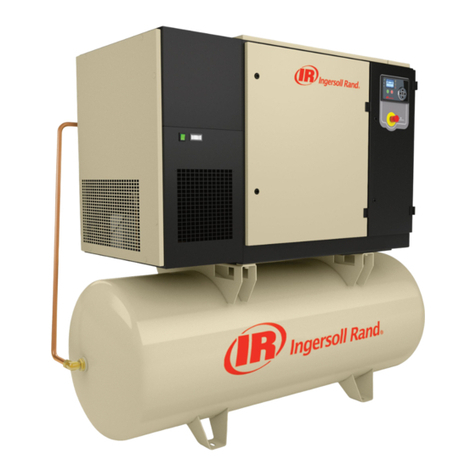
Ingersoll-Rand
Ingersoll-Rand UP5S 11 Installation, operation and maintenance
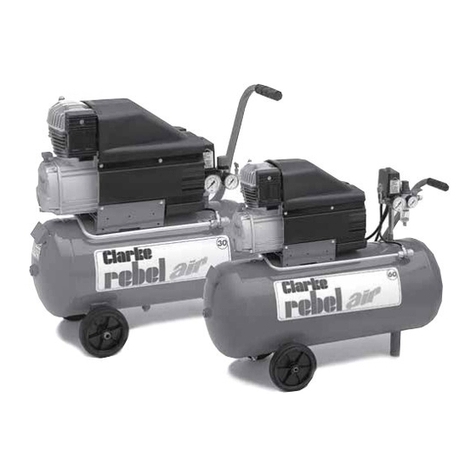
Clarke
Clarke REBEL 30 Operating & maintenance instructions
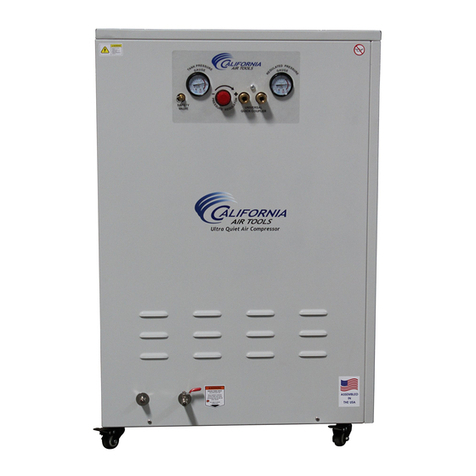
California Air Tools
California Air Tools 10020DSPC owner's manual
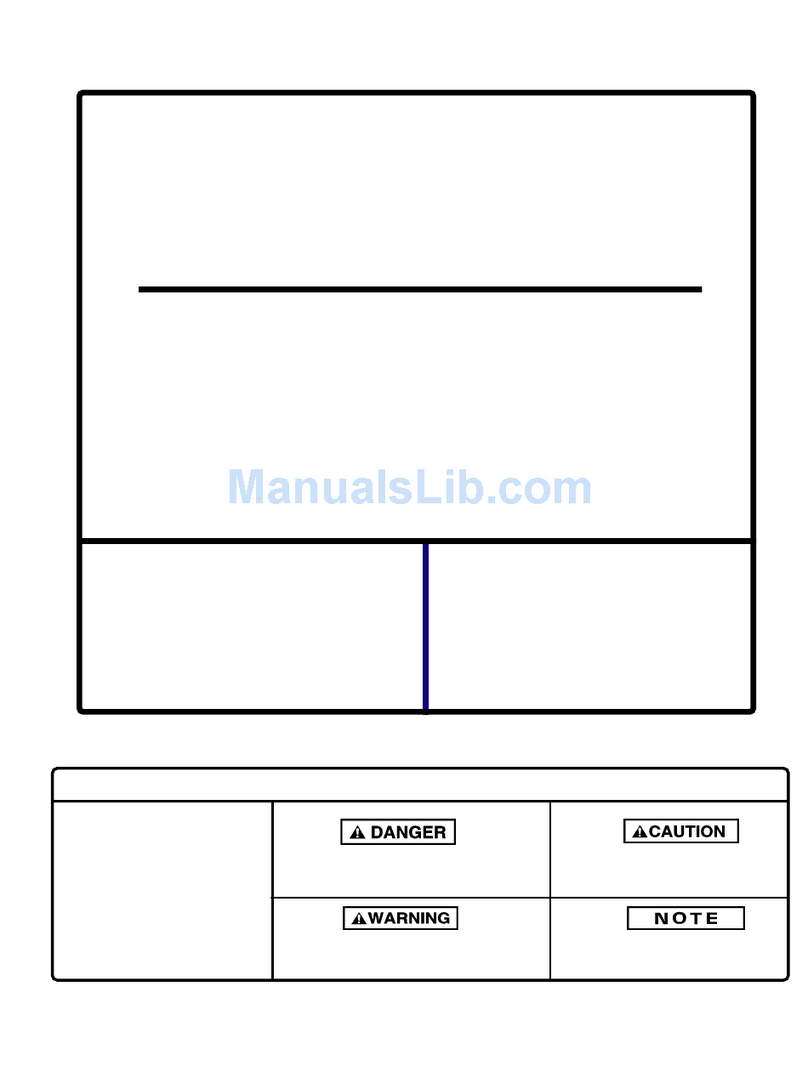
DeVilbiss
DeVilbiss MGAT-1 General manual
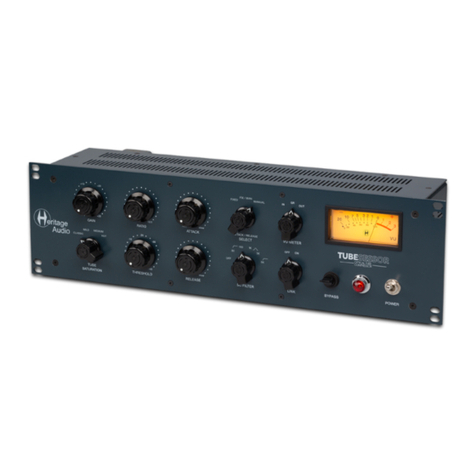
Heritage Audio
Heritage Audio TUBESESSOR user manual
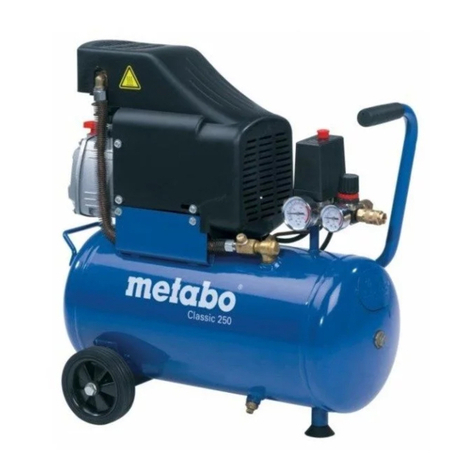
Metabo
Metabo Classic 250 operating instructions
